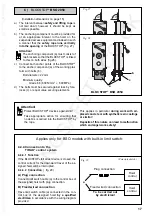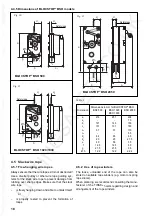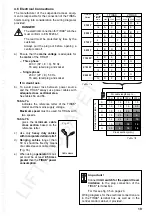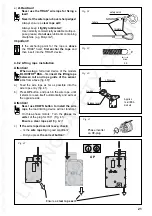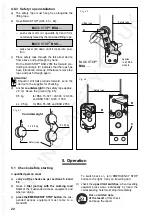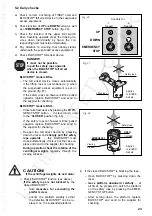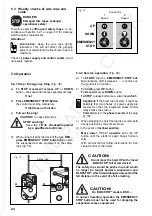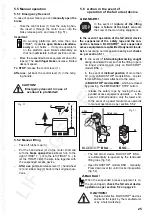
10
B.2 Setting the rated load
Attach rated load (e. g. 500 kg) and lift the
nominal load from ground.
Turn lower regulator to the left as far as the
stop.
Press UP button – the hoist must stop immedi-
ately.
Following each stopping o
f the hoist during
this setting procedure,
press the DOWN button
shortly
so that the upward travel is again possi-
ble.
Step by step
– turn the lower regulator slightly to the right,
– then press UP button,
until lifting of the suspended nominal load is
possible.
Important note for TIRAK
®
with 2 speeds
(pole changing motor):
The control system contains 2 load limiting
devices, the setting must be carried out for
both speeds.
3.8.4.2 Mechanical load limiting device
The load limiting device is installed in the rope drive
and switches off the UPWARD travel in the event of
overload.
A warning signal (lamp/buzzer) is triggered which
does not go off until the cause of the overload has
been removed.
Possible causes for the switching off:
–
overload of the suspended access equipment,
possibly as a result of unfavourable load distribu-
tion
or
–
the suspended access equipment being blocked
by an obstacle during upward travel
Action following switching off:
–
reduce load to such an extent that, or redistribute
it until there is no longer any overload,
or
–
move downwards until the suspended access
equipment is free from the obstacle which must
be removed before travel is continued.
2
1
Fig. 8
3.8.5 Manual operation
Details in chapter 5.5 on page 25.
3.8.5.1 Emergency Descent
In case of power failure you can manually open
the brake with lever (1) (Fig. 8).
3.8.5.2 Manual lifting
With the brake opened the suspended ac-
cess equipment can be lifted with the hand
wheel (2) placed on the motor shaft. (Fig. 8).
3.8.6 Fall arrest devices
Suspended access equipment must be equipped with
a fall arrest device which secures the load against
falling using a safety rope.
The two systems available from the manufacturer of
the TIRAK
®
hoists are described below.
3.8.6.1 BLOCSTOP
®
Model BSA
The fall arrest device model BLOCSTOP
®
BSA is
opened by the loaded lifting rope (fig. 9) and secures
the suspended access equipment against:
a)
rupture of the lifting rope,
b)
failure of the hoist,
c)
interlocking/becoming caught during downward
travel with the result that the lifting rope is no
longer under tension,
d)
inclined position of more than the maximum ad-
missible 14
(on suspended platforms with the
two hoists attached at the ends).
3.8.6.2 BLOCSTOP
®
model BSO
The fall arrest device model BLOCSTOP
®
BSO is
released manually (fig. 10).
The speed of the safety rope is constantly monitored
and the clamping mechanism closed automatically in
the event of a sudden occurrence of excessive speed.
As a result, the suspended access equipment is se-
cured against
a)
rupture of the lifting rope and
b)
failure of the hoist
By pressing the EMERGENCY STOP button the fall
arrest device can also be closed manually in an emer-
gency. This offers the advantage that a defective
hoist can be replaced on the hanging man-riding de-
vice.
The viewing window serves to enable to check the
operation of the centrifugal weights during service.
See section 5.6 on page 25 for action in the event
of operation of the fall arrest device.

















